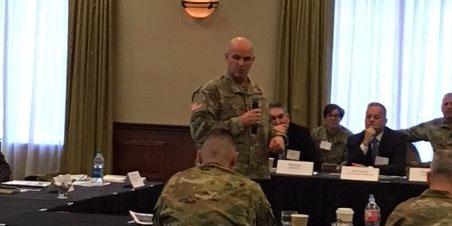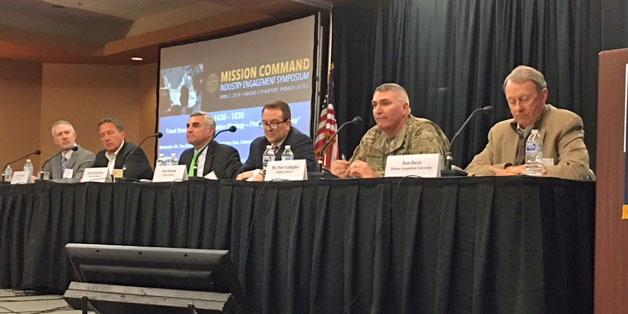Army Opens Lines of Communication
The U.S. Army is making some long-needed changes to the way it’s configuring the networks required to prepare for, conduct and win wars. With the promise of increased resources, the service plans to do more than just upgrade its information technology. Instead, it has designed a strategy that incorporates the successes of the past, adjusts where needed in the present and sets the stage for a future that takes advantage of innovative solutions.
To accomplish these tasks, Army leadership as well as soldiers who face networking challenges every day have opened up to industry during events such as the AFCEA Mission Command Industry Engagement Symposium, which took place April 3 in Kansas City, Missouri. Discussions centered around the Mission Command Network Modernization Implementation Plan, which reflects the Chief of Staff of the Army’s guidance to service leaders to synchronize, develop and deliver capabilities across doctrine, organizational structures, training, materiel, leadership, personnel, facilities and policy.
Maj. Gen. James J. Mingus, USA, director, U.S. Army Mission Command Center of Excellence, admitted that many attendees have heard about network modernization in the past and are justifiably skeptical. Although he could not speak for previous efforts, Gen. Mingus said this time will be different because of the energy and commitment of leadership. While transformation can take many forms—from process revamps to culture overhauls—the current approach aims at working hand-in-hand with the service’s units while also reaching out to industry where it makes sense to do so and ensuring ongoing progress remains as transparent as possible, the general said.
Maj. Gen. Peter Gallagher, USA, director, Network Cross-Functional Team, U.S. Army Mission Command Center of Excellence, described the primary goals of the effort. “We have to prepare the Army for war. Readiness is our number one priority, and we have to fight and win no matter where we go,” he explained. Warfighters must fight, move, shoot, communicate and protect themselves, and the network must be able to enable all of these tasks, the general added.
While creating a network that can accomplish all these tasks appears challenging in its own right, in truth the challenge is even greater. Gen. Gallagher explained that this network also must be simple, intuitive, resilient, mobile and capable of being operated and maintained by soldiers while simultaneously keeping up in a very lethal, volatile fight.
As service leaders took “a good hard look” at previous work, they determined that they have overprescribed their requirements in the past. Consequently, they determined that they don’t want to over-specify them in the future and instead give industry the leeway to put forth open solutions, he added.
Gen. Gallagher explained that the Army spends about $11 billion annually on this network of networks in four mission areas: the enterprise mission network, or Department of Defense Information Network (DODIN); defense intelligence; business mission, which generates readiness; and warfighting. All these areas are interrelated and interdependent, he stated.
“One of the main things we’re trying to accomplish in the enterprise is about establishing the joint information environment, which is about being more effective, efficient and secure," the general explained. "It’s about converging and collapsing a lot of those disparate networks; it’s about making sure we have a situational understanding and being able to see ourselves. We’ve had a very difficult time across the network with so much attack service across this enterprise network because it was built over time."
Some of the priority fixes the Army plans to make include flattening the network by getting rid of stovepipes; increasing the speed of the network; ensuring mobility; and boosting network protection. “In simple terms, we’re trying to take this complex thing that is really a network of networks that is somehow configured into a Frankenstein model that we have today, we’re trying to flatten it, we’re trying optimize it, we’re trying ensure that we adapt and buy solutions that are going to give us the marked advantage that we need, and we’re going to invest in the future in our science and technology efforts and our industry partnerships to get the network we need,” Gen. Gallagher stated.
“We haven’t made an institutional change this drastic since the ’70s,” he added.
To accomplish this task, the Army is taking a “team of teams approach.” Cross-functional teams within the service are examining how changes in one part of the network will affect other parts of the Army. The service also is teaming with academia and industry through organizations like AFCEA, Gen. Gallagher pointed out.
In the spirit of teaming, Gen. Mingus and Maj. Gen. John Morrison Jr., USA, U.S. Army Center of Excellence and Fort Gordon, tag-teamed the explanation of the implementation guidance and objectives of mission command and the networks. Paramount during the process of creating the mission command network modernization has been ensuring the ability to operate with allies around the world.
Gen. Morrison also pointed out the need to simplify systems so that soldiers pick up and learn how to use a piece of technology by following a few simple prompts instead of needing hours of training. Systems have grown too complex in part because of the number of requirements the Army has demanded in the past.
“What we have today is complexity at the edge and that’s the last thing we need,” Gen. Morrison said. Now, the Army wants the complexity of any capability to reside “behind the faceplate” within the enterprise, he stated.
This type of thinking reaches much deeper into the modernization planning. For example, network requirements were determined in great measure based on what capabilities a squad leader may need, and a niche product addressed that need. Simultaneously, requirements were being written based on the needs of a commander, and yet another solution was created to meet that need.
The modernization approach is to turn this thinking around and ask the question, “Who should have access to this network of this information?” By addressing the issue from this perspective, the solutions needed are more about leveraging advances in identity management and less about purchasing niche products that must then fit into an already complex network enterprise.
Despite new thinking, some of the mainstays of Army communications remain. For example, interoperability in both the joint and coalition environments is a must. Cybersecurity must be built into all solutions from the beginning. The ability to “hide in plain noise” will give warfighters an advantage they need in today’s growing electronic warfare environment.
To ensure that this iteration of modernization can take advantage of emerging capabilities, the implementation plan is designed to move forward by adapting innovation in a cascading manner with a successive set of future states in mind. For industry, this approach means that the service will “buy less more often,” Gen. Mingus stated.
The clear message to industry is that the Army wants technologies that are intuitive by nature, survivable and effective in severe environments, protected from cyber threats, interoperable in the joint and multinational operations, standards-based and highly mobile.
During the conference, industry’s message to the Army was equally clear. Maj. Gen. Jefforey Smith, USA (Ret.), vice president, global business development, Harris Corporation, who recently moved from the military to the industry side of the table, pointed out that the Army must better define its requirements to companies. Although industry has the research and development dollars to invest in innovation, he said, firms still must know exactly where to invest those dollars.
Gen. Smith also pointed out that the passion that Army leadership is demonstrating for mission command modernization must be maintained over time. A coalition with industry will help sustain the open lines of communication and bring the current vision to fruition.
Joseph Howard, enterprise account manager and Army tactical business executive, Hewlett Packard Enterprise, shared that it’s important for the Army to make it easier to work with the service by sharing the comments its leaders hear from the field about commercial capabilities. “The end state that’s been explained today is very much achievable in the next two years,” Howard said.







Comments